This inventarisation is limited to the practical game; no longest winning streaks; youngest grandmasters; selfmates in 418, tablebase wins in 517, greatest number of bald players in a tournament. "This is the record" means: "this is the record as known & recognized by me."
Some of these records, like Longest Game and Most Queens, have been the subject of publications for a century; others are meant as an opening bid. I'm open to new records and suggestions for new categories, but only "serious and verifiable tournament games", although that is an elastic concept, will be considered. Records set by correspondents themselves will be examined with suspicion. Computer games are out.
Chess Query Language (see my article) was a major help. It facilitated old and enabled new searches, prompting a few new categories.
Most games can be played over on the right; many can be downloaded in a file recordgames.zip.
Longest Game:
269
The moves of games marked * are not available. I guessed the times for some rapid and blitz games, assuming all the incremental seconds were used.
| 269 | 20:15 h. | I. Nikolic - Arsovic | ½-½ | Belgrade 1989 |
| 239 | 8:40 h. | Danin - Azarov | 1-0 | Czech team championship, 2016 |
| 237 | 2 h. | Fressinet - Kosteniuk | 0-1 | Villandry 2007, rapid |
| 233 | 7:15 h. | Rozen - Efroimski | ½-½ | Haifa, Israeli Championship 2021 |
| 228 | 7 h. | Sanal - Can | ½-½ | Plovdiv, European Ch. 2012 |
| 227 | 1:07 h. | T. L. Petrosjan - Sammour Hasbun | ½-½ | Dos Hermanas Internet 2007, blitz |
| 217 | ?? | Dann - Kovchan | 0-1 | ZMDI Open, Dresden 2017 |
| 215 | 0:22 h. | Ivanchuk - Leko | ½-½ | World Blitz Ch., Moscow 2007 |
| 213 | 7:30 h. | Zawadzka - Lach | ½-½ | Warsaw, ch Poland (women) 2011 |
| 210 | 7:30 h. | Neverov - Bogdanovich | 0-1 | Kiev, ch Ukraine 2013 |
| 209 | 16:40 h. | Chekhlov - Stavrinov * | ½-½ | Riga, City Ch. 1988 |
| 207 | ?? | Abramov - Fedoseev | ½-½ | St. Petersburg, rapid 2013 |
| 204 | ?? | Shanava - Emiroglu | ½-½ | 40th Olympiad Open, Istanbul 2012 |
| 204 | ?? | Dubov - Malakhov | ½-½ | European Blitz Championship, Warsaw 2013 |
| 202 | 5:30 h. | Gil-galad - izit | 0-1 | ICC team 45 45 2007 |
| 201 | ?? | Mirzoev - Sanal | ½-½ | Nakhchivan Open 2013 |
| 200 | ?? | Meiers - Rausis * | ½-½ | Riga, Ch. Latvia 1989 |
| 200 | 16:20 h. | Wegner - Johnsen | ½-½ | Gausdal 1991 |
The first recorded 150+ move game was Lipschütz - Bird, New York 1889 (½-½), 159 moves. In 1907, the record was broken by Wolf - Duras, Karlsbad (1-0), 168 moves, which held it until Pilnik - Czerniak, Mar del Plata 1950, (½-½), 191 moves. That game was in the Guinness Book of Records as "the longest game ever played" for ages. (Pilnik also drew a 150-move game vs. De Freitas in that same tournament.) By November 2013, Pilnik - Czerniak had dropped out of the top-25 longest games, but it can perhaps still be seen as the longest serious game at top level.
It was not surpassed until 1980, by Stepak - Mashian, Israel Ch. semifinals (1-0), 193 moves - still, at 24½ hours, the longest game in time; a record it will forever hold.
After that, the record was held by Martinovsky - Jansa, Gausdal 1987, ½-½, 194 moves; Chekhlov - Stavrinov, Riga 1988, ½-½, 209 moves (the first 200+ game),
and from 1989 on by the still unsurpassed 269 moves of Nikolic - Arsovic.
Danin - Azarov, at 239 moves, is the longest decisive game.
As of 28 March 2021, the top-10 are all 210 moves or more.
In Zawadzka - Lach, Black missed a good opportunity to break the 300-move barrier. After 209...g2 210.a8Q Qxa8+ 211.Kxa8 g1Q, a Q+g-pawn vs. Q endgame would have arisen which, according to the tablebases, is still a draw, but which they might have easily played on for another 100 moves.
Sanal has two games of over 200 moves.
Back to the list
There are draws in 2, 1 and even 0 moves, forfeited games of 1 move, joke games of 3 moves and what not, but the shortest decisive game ever played in a serious tournament is:
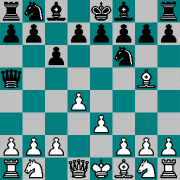 1.d4 Nf6 2.Bg5 c6 3.e3 Qa5+ and White resigned.
1.d4 Nf6 2.Bg5 c6 3.e3 Qa5+ and White resigned.
It happened in Djordjevic - Kovacevic, Bela Crkva 1984
and
Vassallo - Gamundi, tt Spain, Salamanca 1998.
This position occurred more often, and White did not always resign; in Mory - Hareux, Besançon 1999, he even drew.
But nothing will prevent "Gibaud - Lazard, Paris 1924, 4 moves" being published as the shortest decisive "master game": 1.d4 Nf6 2.Nd2 e5 3.dxe5 Ng4 4.h3
Ne3 and White resigned. Almost everything is incorrect about that statement: it was not a master game, White was perhaps not poor Gibaud, it was not played in 1924, it was 5 instead of 4 moves - and even at 4 moves, it would have had to share honours with other games.
What is true is that in his autobiography, Lazard gave a friendly game "Amateur" - Lazard, played in Paris, "around 1922", which went 1.d4 d5 2.b3 Nf6 3.Nd2 e5 4.dxe5 Ng4 5.h3 Ne3 and White resigned. Here, 5.h3 is not as stupid a blunder as in the shorter version, because White could at least have hoped to gain a tempo after 5...Nxe5 6.Bb2. "Amateur" becoming Gibaud, and Gibaud the proverbial patzer, is not Lazard's fault; he mentioned "a very strong player whose talent is done no justice by this game."
In fact, Gibaud was champion of France no less than four times. He didn't like this 4-move game going around with his name attached. And when in 1937 the British magazine Chess published it as "the shortest tournament game ever played, from a Paris Championship", he protested his innocence.
In the next issue, Chess answered: "He never lost any tournament game in four moves. Searching his memory he recalls a skittles he once played against Lazard, a game of the most light-hearted variety, in which, his attention momentarily distracted by the arrival of his friend Muffang, he played a move which allowed a combination of this genre - but certainly not four moves after the commencement of the game. Rumour, he said, must have woven strange tales about this game."
Lazard was of master strength too, but he is better
known as a composer of endgame studies and problems.
An even more understandable variation of this game has occurred several times: 1.d4 Nf6 2.Nd2 e5 3.dxe5 Ng4 4.Ngf3 Be7 5.h3 Ne3 etc.
For more on very short games, see this
Dutch column
and item 149 in my
Open Chess Diary.
Back to the list
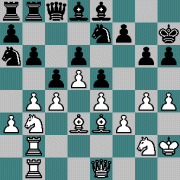 White to play
White to play
Rogoff - Williams
Stockholm, World Junior ch, 1969
94.bxc5 finally broke the spell. The game is reputed to have ended in a draw at move 221, but no moves beyond move 106 have surfaced.
In two cases, the game ended before there was any capture.
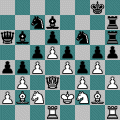 White to play
White to play
Meijfroidt - Lenoir
Veurne 2000
White overstepped the time limit here at move 72.
 White to play
White to play
Filipowicz - Smederevac
Polanica Zdroj, 1966
In this position after Black's 70th move, the game was declared a draw.
According to Filipowicz, he had offered a draw twice in vain, and now he baffled his opponent by claiming a draw on the ground of the 50-move rule - the most crowded position in which that rule was ever invoked. (But not the earliest, see below.)
Back to the list
Longest decisive game without a capture: 31 moves
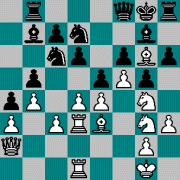 Black to play
Black to play
Nuber - Keckeisen
Mengen 1994
White's last move had been 31.Qf2-a2+, after which Black resigned.
Back to the list
Quickest exchange game: 17 moves.
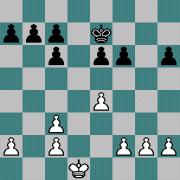 Black to play
Black to play
Rodriguez - Manzano
Gijon 1999
White's last move had been 17.Ke2xRd1. A draw was agreed after a dozen more moves.
Back to the list
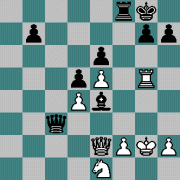
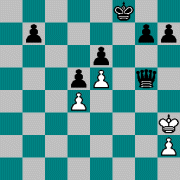
Sibilio - Mariotti, Ravenna 1982
In the diagram on the left, White tried a stalemate trap, and Black fell for it. 23.f3 Rxf3? 24.Nxf3 Bxf3+ 25.Qxf3 Qd2+ 26.Kh3 Qxg5 27.Qf8+ Kxf8 (see diagram right) ½-½
Back to the list
Earliest 50-move rule draw: move 69
In Pouw - Van Dort, tt Oegstgeest 2005, Black rightfully claimed a 50-move rule draw at move 69.
Back to the list
Longest consecutive series of captures: 17 half-moves
Blodig - Wimmer, Germany 1988
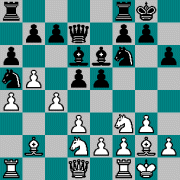
Before |
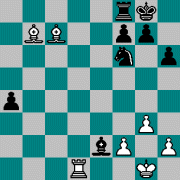
After |
12...dxc4 13.dxc4 Nxc4 14.Nxc4 Bxc4 15.Nxe5 Bxe5 16.Bxe5 Qxd1 17.Rfxd1 axb5 18.Bxb7 Rxa4 19.Rxa4 bxa4 20.Bxc7 Bxe2 and not too much later, White resigned.
This record was tied in
Rudd - Roberson, British ch, Swansea 2006
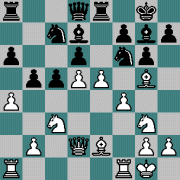
Before |
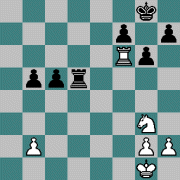
After |
Longest consecutive series of captures on one square: 12
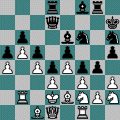 Weiss - Burschowsky, Austria 1995
Weiss - Burschowsky, Austria 1995
37.hxg4 hxg4 38.fxg4 Nhxg4 39.Nhxg4 Nxg4 40.Nxg4 Bxg4 41.Bxg4 Qxg4 42.Qxg4 Rxg4 and 8 moves later, White resigned.
Back to the list
Most captures by one piece: 11
The white Queen in Lyell - Friedland, London 2001, captured 11 pieces.
Back to the list
Longest series of moves by one piece: 80
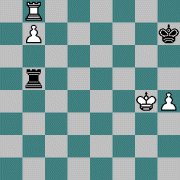 Black to play
Black to play
Yueh Wei Po - Arora
Olympiad Turin, 2006
67...Rb4+ was the first of 80 consecutive Rook moves after the last of which, at move 147, a draw was agreed.
This record had long been in the hands of a Queen from the times of Queen Victoria, with 73 consecutive moves.
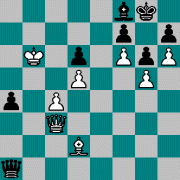 Black to play
Black to play
Mackenzie - Mason
London 1882
From 72...Qd1 to 144...Qf4, when a draw was agreed, the black Queen never had a moment's rest.
Rebickova - Voracova, Girls under 16 ch, Czech Republic 1995, ended with 74 checks by the black Queen.
Back to the list
Greatest number of checks: 141 (both sides together); 98 (one side.)
In the 200-move game Wegner - Johnsen, Gausdal 1991 a total of 141 checks were given, of which 98 by White alone.
Back to the list
Longest mutual series of checks: 6
Two joint record holders.

Black to play
Zarrouati - Brauckmann
Toulouse 1990
27...Ng4+ 28.Kxf3+ Nde5+ 29.Rxe5+ Nxe5+ 30.Qxe5+ and after 30...Be6 31.Bxe6 Rh5 32.Bf5+ Kf8, Black resigned.
White to play
Cardona - Conejero
Mislata (Spain), 2003
22.Rg1+ Bxg1+ 23.Rxg1+ Qg3+ 24.Rxg3+ fxg3+ and some ten moves later, Black resigned.
In a problem, a series of 37 consecutive mutual checks has been achieved.
Back to the list
Longest sequence without captures: 151
In Wegner - Johnsen the last capture was on move 49; there followed 151 moves without a capture.
As there were promotions in that series, there is a separate record for the same set of pieces.
In Rozen - Efroimski, Haifa 2021 there was a series of 150 captureless and promotionless moves, from move 68 to 218.
Back to the list
Many different curiosities would fall under this heading - how long pieces stay on their original squares, or on squares they reach later. One piece, combinations of pieces, sets of pieces, all pieces... in this domain, we come dangerously close to the point where every chess game is the record holder at being itself. As a measure of immobility, I take the number of moves pieces or pawns stayed at their original squares - until they played, were captured, or the game was over.
Pawn: 225...gxf6+; Rozen - Efroimski, Haifa 2021
Knight: 85 (never played); Galanov - Kosanski, Budapest 1994
Bishop: 81 (never played); Levitt - Lev, Tel Aviv 1989
Rook: 105 (never played); Rebickova - Voracova, Czech Republic 1995
Queen: 76...Qa8; Alvarado - Carvajal, San Jose (Costa Rica) 2001
King: 70...Kd7; Cacho - Suba, Spain 2001
Both Kings: 47 (never played); Thorhallsson - Johannesson, Hafnarborg 2003
All pieces of one side (White): 18.Qh5+; Diemer - Heiling, Nuremberg 1984
Honorable Mentions:
In that strange game Mackenzie - Mason, the black King was at g8 for 136 moves.
Vidarsson - Hjartarson, Iceland 1994, began with 1.e4 e5 and those pawns were still there when a draw was agreed after move 180.
Valkesalmi - Agopov, Finland 1998, began with 1.c4 c5 2.b3 d5
and that pawn stayed on d5 until it was captured with 184.Nxd5
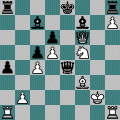 Also to be noted is Szabo - Ristoja, Helsinki 1975. In
the diagram, after 41.Bf3, Black resigned. All four Rooks are still on
their original squares, without having made one move between them.
Also to be noted is Szabo - Ristoja, Helsinki 1975. In
the diagram, after 41.Bf3, Black resigned. All four Rooks are still on
their original squares, without having made one move between them.
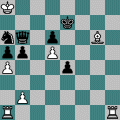 In Pia Cramling - Landenbergue, Biel 1991, 56.Rh7+ was White's first Rook move.
In Pia Cramling - Landenbergue, Biel 1991, 56.Rh7+ was White's first Rook move.
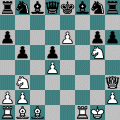 In Samms - Bainbridge, England 1994, all the black pieces were (back) in their original places when the game finished with 21...Nf6 22.Bxg6+ Ke7 23.Nxf7 Be6 24.Re1 Qc8 25.Nc5 and Black resigned.
In Samms - Bainbridge, England 1994, all the black pieces were (back) in their original places when the game finished with 21...Nf6 22.Bxg6+ Ke7 23.Nxf7 Be6 24.Re1 Qc8 25.Nc5 and Black resigned.
Back to the list
In Lipschütz - Bird, New York 1889, the Nb1 made 92 moves.
In Wegner - Johnsen, Gausdal 1991, the Ph2 made 108 moves, of which 102 as a Queen.
In Hansen - Kovachev, Denmark 2009, the Bc1 made 111 moves.
In Bozkurt - Tanrivermis, Kusadasi 2004, the Ke8 made 125 moves.
In I. Nikolic - Arsovic, Belgrade 1989, the Ra8 made 156 moves.
In Rozen - Efroimski, Haifa 2021, the Qd8 made 166 moves.
Another measure of mobility is the number of different squares that pieces visit. I found 33 games where all 64 squares have been visited. The shortest of these is the 87-move game Rantanen - Smiltiner, Olympiad Munich 1958, which is also the one in which this happened at the earliest moment, at move 81 when Black played Ra3.
In two games, I. Nikolic - Arsovic, Belgrade 1989 and Fressinet - Kosteniuk, Villandry 2007 one side visited 62 different squares; White and Black respectively.
In Babrikowksi - Lai Hop Duong, tt Germany 1994, the black King alone visited 45 different squares.
In Rozen - Efroimski, Haifa 2021, the black Queen visited 46 different squares.
In Danin - Azarov, Czech Republic 2016, the a1-Rook visited 53 different squares.
In Gonzalez - Karlsson, Sitges 2009 the c8-Bishop visited 27 different squares.
In Lugovoi - Skatchkov, Petersburg 1999, the g8- Knight visited 37 different squares.
In Wegner - Johnsen, Gausdal 1991, the h2-pawn, including its next life as a Queen, visited 47 different squares.
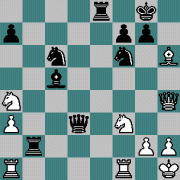 Black to play
Black to play
Davis - Panchanathan
Minneapolis 2005
In the diagram, after White's 23th move, Black had a choice of 79 moves.
Back to the list
Longest symmetrical game: 16 moves.
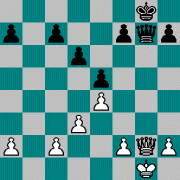 Rotlevi - Eljaschoff, St. Petersburg 1909
Rotlevi - Eljaschoff, St. Petersburg 1909
1.e4 e5 2.Nf3 Nf6 3.Nc3 Nc6 4.Bb5 Bb4 5.O-O O-O 6.d3 d6 7.Bxc6 Bxc3 8.Bxb7 Bxb2 9.Bxa8 Bxa1 10.Bg5 Bg4 11.Qxa1 Qxa8 12.Bxf6 Bxf3 13.Bxg7 Bxg2 14.Bxf8 Bxf1 15.Qxf1 Qxf8 16.Qg2 Qg7 (see diagram) ½-½
Back to the list
Longest unclaimed repetition: 15.
White to play
Suttor - Lin Zhigen
Australian Open, Tuggeranong 2006
There followed 32...Rg6 33.Kh1 Rf6 34.Kg1 Rg6 35.Kh1 Rf6 36.Kg1 Rg6 37.Kh1 Rf6 38.Kg1 Rg6 39.Kh1 Rf6 40.Kg1 Rg6 41.Kh1 Rf6 42.Kg1 Rg6 43.Kh1 Rf6 44.Kg1 Rg6 45.Kh1 Rf6 46.Kg1 Rg6 47.Kh1 Rf6 48.Kg1 Rg6 49.Kh1 Rf6 50.Kg1 Rg6 51.Kh1 Rf6 52.Kg1 Rg6 53.Kh1 Rf6 54.Kg1 Rg6 55.Kh1 Rf6 56.Kg1 Rg6 57.Kh1 Rf6 58.Kg1 Rg6 59.Kh1 Rf6 60.Kg1 Rg6 61.Kh1 Rf6 62.Kg1 and after this 15-fold repetition, Black played 62...Kh7. The game was drawn - without further repetitions - at move 119.
Back to the list
Joint record holders:
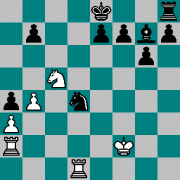
Neshewat - Garrison Detroit 1994 48...O-O |
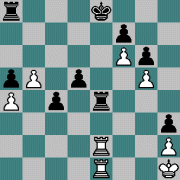
Somogyi - Black New York 2002 48...O-O-O |
Back to the list
Greatest number of castlings: 3
Heidenfeld - Kerins, Dublin 1973
1.e4 e6 2.d4 d5 3.Be3 Nf6 4.e5 Nfd7 5.f4 c5 6.c3 Nc6 7.Nf3 Qb6 8.Qd2
c4 9.Be2 Na5 10.O-O f5 11.Ng5 Be7 12.g4 Bxg5
13.fxg5 Nf8 14.gxf5 exf5 15.Bf3 Be6 16.Qg2 O-O-O
17.Na3 Ng6 18.Qd2 f4 19.Bf2 Bh3 20.Rfb1 Bf5 21.Nc2 h6 22.gxh6 Rxh6 23.Nb4
Qe6 24.Qe2 Ne7 25.b3 Qg6+ 26.Kf1 Bxb1 27.bxc4 dxc4 28.Qb2 Bd3+ 29.Ke1 Be4
30.Qe2 Bxf3 31.Qxf3 Rxh2 32.d5 Qf5 33.O-O-O
Rh3 34.Qe2 Rxc3+ 35.Kb2 Rh3 36.d6 Nec6 37.Nxc6 Nxc6 38.e6 Qe5+ 39.Qxe5
Nxe5 40.d7+ Nxd7 0-1
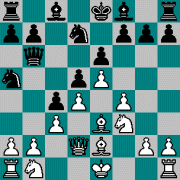
Position after 9...Na5 |

Position after 16.Qg2 |
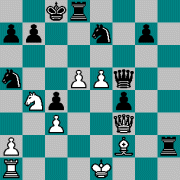
Position after 32...Qf5 |
Back to the list
Longest en prise: 24 (minor piece); 17 (Rook.)
I define en prise as a piece being attacked by a pawn.
In the records I had here before, I also counted non-captures where the pawn was pinned, or the non-capturing side was in check. I discarded those, but these two must be shown:
Miles - Ljubojevic, Tilburg 1986
Here, an attacked Knight stays put for 27 moves, the last 24 of which its capture would have been legal.
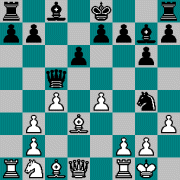
Position after 12.h3 |
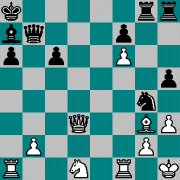
Position after 39.Qd3 |
12...h5 13.Qd2 Qe5 14.f4 Qc5+ 15.Kh1 Bd7 16.Nc3 e6 17.Qe2 Bd4 18.Bd2 Qb6 19.Nd1 a6 20.Ba5 Qa7 21.Bb4 Qb6 22.Ba5 Qc5 23.Qe1 e5 24.Bb4 Qb6 25.Ba5 Qa7 26.f5 gxf5 27.exf5 Bc6 28.Be4 Kd7 29.f6 Rag8 30.Bxc6+ bxc6 31.Qe4 Qb7 32.Bc3 Ba7 33.b4 Kc8 34.c5 dxc5 35.Qf5+ Kb8 36.Bxe5+ Ka8 37.bxc5 Bxc5 38.Bg3 Ba7 39.Qd3 Ne3 White won after 60 moves.
Morozevich - Vachier-Lagrave, Biel 2009
And in this game, a Rook is en prise during 24 moves, on 17 of which it would have been legal to capture it.
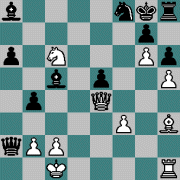
Position before 27...Rh8-h7 |
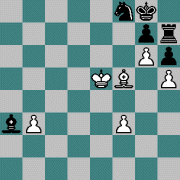
Position before 51...Rh7-h8 |
27.h5 Rh7 28.Re1 Bxc6 29.Qxc6 Bd4 30.Kd2 Qxb2 31.Qc4+ Kh8 32.Kd3 a5 33.Qc8 Qa3+ 34.Ke4 b3 35.cxb3 a4 36.Rb1 Qb4 37.Qc4 Qb7+ 38.Qd5 Qb4 39.Qc4 Qd2 40.Bg4 a3 41.Qf7 Qc2+ 42.Kd5 Qc5+ 43.Ke4 a2 44.Rc1 a1Q 45.Rxc5 Bxc5 46.Qd5 Qe1+ 47.Kd3 Qd1+ 48.Kc4 Qxd5+ 49.Kxd5 Ba3 50.Bf5 Kg8 51.Kxe5 Rh8 and Black won after 25 more moves.
Back to the list
In Ng - Erigayama, Manila 1992, 15 pieces, 8 white and 7 black ones, were captured on d5.
Back to the list
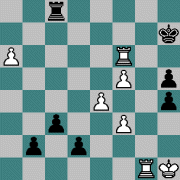 Position after 59.Rxf6
Position after 59.Rxf6
Smyslov - Botvinnik
ch USSR 1941
There are 9 passed pawns here - but perhaps the pawns f3 and h5 should not be counted as such. In that case, many games with 8 passed pawns are joint record holders.
Two of those games are special, with 7 passed pawns for one side, and 1 for the other.
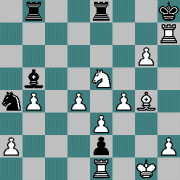
Puth - Mattern Heimbach 1997 Position after 32.Rxh7+ |
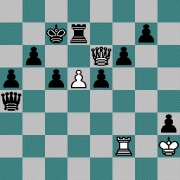
Stoeber - Kasnitz Germany 1999 Position after 44...Qxa4 |
Back to the list
Most adjacent pawns on 7th rank: 4
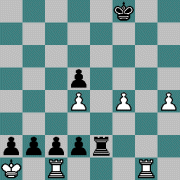 Lee - Shoosmith, London 1904 is the only game in which one side had 4 adjacent pawns on the 7th rank. Black's last move had been b3-b2+, and after 58.Kxb2 d1Q 59.Kc3 Qd2+ 60.Kb2 a1Q+ 61.Kxa1 Qc3+, White resigned.
Lee - Shoosmith, London 1904 is the only game in which one side had 4 adjacent pawns on the 7th rank. Black's last move had been b3-b2+, and after 58.Kxb2 d1Q 59.Kc3 Qd2+ 60.Kb2 a1Q+ 61.Kxa1 Qc3+, White resigned.
Back to the list
Longest living quadrupled pawns: 23 moves
Black to play
Kovacs - Barth
Balatonbereny 1994
White had just played 22.bxc4 There followed:
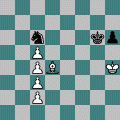 22...Rc8 23.Nd6 Rc6 24.Ne4 Rac8 25.Rd7 R6c7 26.Rd6 Rc6 27.Rfd1 Bf8 28.Rxc6 Rxc6 29.Rd8 Kf7 30.Rd7+ Be7 31.Rxa7 h6 32.Bc1 g5 33.h4 gxh4 34.Bf4 e5 35.Bxe5 Re6 36.Nd6+ Kg6 37.Bd4 Nb8 38.Ra8 Nc6 39.Rg8+ Kh5 40.Nf5 Rg6+ 41.Rxg6 Kxg6 42.Nxe7+ Nxe7 43.Kh3 Nc6 44.Kxh4 (see diagram) and a draw was agreed.
22...Rc8 23.Nd6 Rc6 24.Ne4 Rac8 25.Rd7 R6c7 26.Rd6 Rc6 27.Rfd1 Bf8 28.Rxc6 Rxc6 29.Rd8 Kf7 30.Rd7+ Be7 31.Rxa7 h6 32.Bc1 g5 33.h4 gxh4 34.Bf4 e5 35.Bxe5 Re6 36.Nd6+ Kg6 37.Bd4 Nb8 38.Ra8 Nc6 39.Rg8+ Kh5 40.Nf5 Rg6+ 41.Rxg6 Kxg6 42.Nxe7+ Nxe7 43.Kh3 Nc6 44.Kxh4 (see diagram) and a draw was agreed.
Back to the list
Together with 'Longest game', this is the most popular, controversial and hoaxed record. In some databases, there is a game "Sumpter - King, Australia 1965" with 7 Queens, which was later proven to be spurious. The famous game "Alekhine - Grigoriev, Moscow 1915" with 5 Queens, is also a mystification.
In recent years however, there have been two genuine tournament games in which 6 Queens appeared simultaneously. In one game, they were on the board for a 7-move sequence.
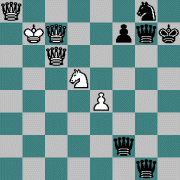 Black to play
Black to play
Szalanczy - Nguyen
Budapest 2009
White had just played 58.a8Q There followed 58...Qb1+ 59.Nb6 Nf6 60.e5 Ng4 61.Qae8 Qff5 62.Qce7 Nh6 63.Kc7 Qbe4 64.Nd5 Qfxe5+ when six Queens had been present for a full 7 moves; 14 half-moves. After 65.Qxe5 Qgxe5+ 66.Qxe5 Qxe5+ 67.Kd8 Kg7 68.Ne7 Qb8+ 69.Kd7 Qa7+ 70.Kd6 Qa3+ 71.Kd7 Qd3+ 72.Ke8 Qh3 73.Qd5 Qg4 74.Qe5+ f6 75.Qd5 Qa4+, a draw was agreed.
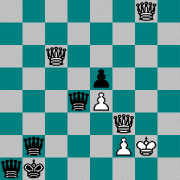 Black to play
Black to play
Anton - Franco
XXI Elgoibar Magistral, 2011
This is the position after 73.g8Q Looks drawish and is drawish, but after 73...Qaa3 74.Qgg3 Qxf3+ 75.Qxf3 Qc2 76.Qb5+ Qcb2 77.Qfd3+ Qxd3 78.Qxd3+ Kc1 79.Kf3 Qd4 80.Qe2 Qd6 81.Qc4+ Black made the terrible blunder 81...Kd2 and had to resign after 82.Qd5+
Back to the list
Longest 4-Queen sequence: 21 moves
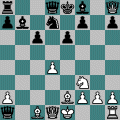
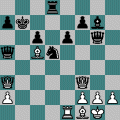 Milov - Timofeev, Canarias en Red, Internet 2004
Milov - Timofeev, Canarias en Red, Internet 2004
With 12...bxa1Q 13.gxh8Q a second pair of Queens had just appeared, and
only with 33...Qxa3 34.Qxa3, one pair was exchanged.
Back to the list
Earliest double polygamy: move 7
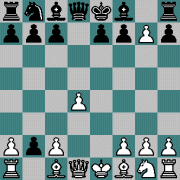 Casper - Heckert, GDR 1975
Casper - Heckert, GDR 1975
1.e4 Nf6 2.Nc3 d5 3.e5 d4 4.exf6 dxc3 5.d4 cxb2 6.fxg7
(see diagram) bxa1Q 7.gxh8Q White won this game at move 23.
Back to the list
 Boleslavsky - Kasparian, Parnu 1947
Boleslavsky - Kasparian, Parnu 1947
White had just promoted with 34.d8Q Both Queens remained on the board to the end of the game, which came at move 89 when Black resigned.
Back to the list
In three games, Panchenko - Vnukov, Voronezh 1999; Kubikova - Novy, Polsen 2003 and Marinkov - Jovicic, Belgrade 2005, a total of 6 pawns promoted to Queens. Kubikova - Novy is special in that it is also the only serious game in which one side promoted four times.
Back to the list
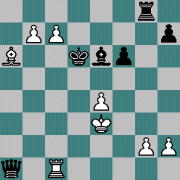 White to play
White to play
Schweber - Wexler
Buenos Aires 1964
46.c8N+ Rxc8 47.bxc8N+, and Black resigned.
This is the only game with two Knight promotions that were the strongest
move. Promotions to Queen would have been equally strong, but as the Knight promotions were checks, they were more obvious, and therefore genuine.
Back to the list
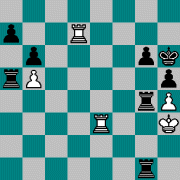 White to play
White to play
Serper - Navrotescu
Oakham 1988
Black had just played 46...g1R That Rook promotion was not forced (46...Ra1 was a quicker win), but as 46...g1Q 47.Rh7+ would have been stalemate, it was more than a joke. White resigned.
Back to the list
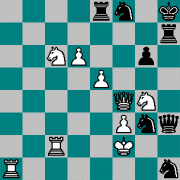 White to play
White to play
Szabo - Ivkov
Belgrade 1964
After 49...h2-h1N+, there followed: 50.Kg1 Nd7 51.Rh2 Qxh2+ 52.Nxh2 Ne2+ 53.Kxh1
and White resigned on move 93. With 7 half-moves, this is the longest 5-Knight sequence.
Back to the list
Longest 3-Knight sequence: 13 moves
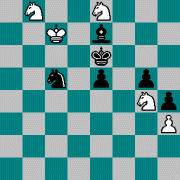 Skrobek - Kornasiewicz, Wisla 1992
Skrobek - Kornasiewicz, Wisla 1992
White had just played 70.b8N There followed: 70...Kf5 71.Nc6 Bf8 72.Ncxe5 Ne6+ 73.Kc6 Nf4 74.Nef6 Bg7 75.Nfd7 Nxh3 76.Kd6 Ng1 77.Nh2 h3 78.Neg4 Nf3 79.Kd5 Kf4 80.Nf2 Ng1 81.Nc5 Kg3 82.Nce4+ Kxh2 and 2 moves later a draw was agreed.
Back to the list
A promoted Queen in Wegner - Johnsen, Gausdal 1991, made 102 moves.
A promoted Rook in Gluzman - Sabic, Sydney 1992, made 3 moves.
A promoted Bishop in McShane - Wilhelmi, Lippstadt 1998, made 7 moves,.
A promoted Knight in Antoshin - Simagin, Moscow 1952, made 33 moves.
Back to the list
(c) Tim Krabbé, 1999 - 2021
With thanks to David Paulowich; Lewis Stiller and Gady Costeff (for Chess Query Language); Harold van der Heijden; Dennis Monokroussos; Rob Verhoeven; René Olthof; Ken Whyld; Alain Pallier; Jack Goossens; Eduardo Bauzá Mercere; Joop Simmelink; Øyvind Pedersen; Gian-Carlo Proscutto; José Antônio Fabiano Mendes; Wiebe Cnossen; Galder Orobengoa; Sampsa Lahtonen; David Yound; Oded Ross and many others.
Comments and suggestions | Top of the page | Main chess page | Main page |